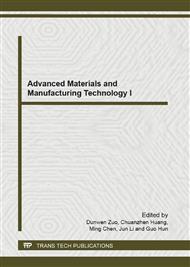p.89
p.93
p.97
p.101
p.106
p.112
p.118
p.122
p.126
Modeling Growth Ring Mechanical Properties of Coniferous Wood Based on FEM
Abstract:
The mechanical properties’ modeling of coniferous growth ring based on finite element method is present in this paper. With the basic unit boundary conditions of stress and displacement, the constitutive relation is established between macro and micro-volume field. The multi-layer model of growth ring is 3 layers, such as early wood, transition wood and latewood layer. The first order displacement field equation is substituted into the micro-variable differential to build the balance equation which has the periodic characteristics. Single-cell finite element model is calculated out using APDL language programming, and the visual results are obtained directly by the ANSYS program output window. With the FEM model, imposing the load on it, the simulation result show that it can calculate out the mechanical properties of material. Modeling Growth Ring Mechanical Properties of Coniferous Wood based on FEM
Info:
Periodical:
Pages:
106-111
Citation:
Online since:
January 2012
Authors:
Price:
Сopyright:
© 2012 Trans Tech Publications Ltd. All Rights Reserved
Share:
Citation:


